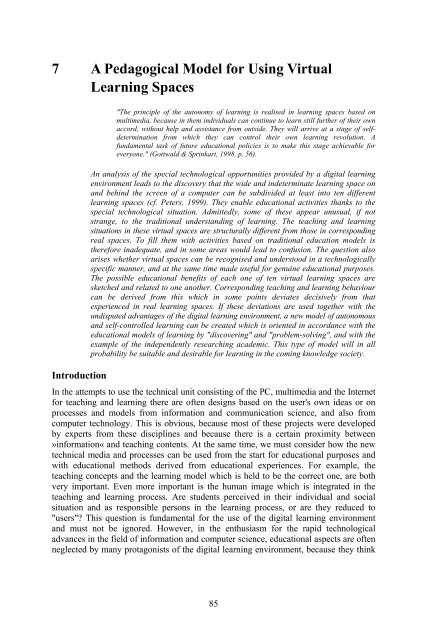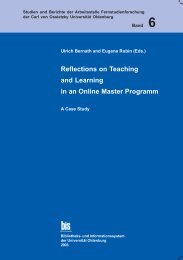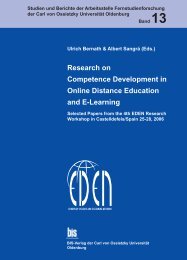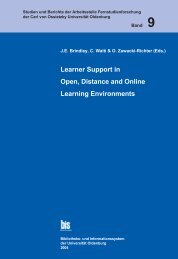Distance Education in Transition - Master of Distance Education ...
Distance Education in Transition - Master of Distance Education ...
Distance Education in Transition - Master of Distance Education ...
Create successful ePaper yourself
Turn your PDF publications into a flip-book with our unique Google optimized e-Paper software.
7 A Pedagogical Model for Us<strong>in</strong>g Virtual<br />
Learn<strong>in</strong>g Spaces<br />
Introduction<br />
"The pr<strong>in</strong>ciple <strong>of</strong> the autonomy <strong>of</strong> learn<strong>in</strong>g is realised <strong>in</strong> learn<strong>in</strong>g spaces based on<br />
multimedia, because <strong>in</strong> them <strong>in</strong>dividuals can cont<strong>in</strong>ue to learn still further <strong>of</strong> their own<br />
accord, without help and assistance from outside. They will arrive at a stage <strong>of</strong> selfdeterm<strong>in</strong>ation<br />
from which they can control their own learn<strong>in</strong>g revolution. A<br />
fundamental task <strong>of</strong> future educational policies is to make this stage achievable for<br />
everyone." (Gottwald & Spr<strong>in</strong>kart, 1998, p. 56).<br />
An analysis <strong>of</strong> the special technological opportunities provided by a digital learn<strong>in</strong>g<br />
environment leads to the discovery that the wide and <strong>in</strong>determ<strong>in</strong>ate learn<strong>in</strong>g space on<br />
and beh<strong>in</strong>d the screen <strong>of</strong> a computer can be subdivided at least <strong>in</strong>to ten different<br />
learn<strong>in</strong>g spaces (cf. Peters, 1999). They enable educational activities thanks to the<br />
special technological situation. Admittedly, some <strong>of</strong> these appear unusual, if not<br />
strange, to the traditional understand<strong>in</strong>g <strong>of</strong> learn<strong>in</strong>g. The teach<strong>in</strong>g and learn<strong>in</strong>g<br />
situations <strong>in</strong> these virtual spaces are structurally different from those <strong>in</strong> correspond<strong>in</strong>g<br />
real spaces. To fill them with activities based on traditional education models is<br />
therefore <strong>in</strong>adequate, and <strong>in</strong> some areas would lead to confusion. The question also<br />
arises whether virtual spaces can be recognised and understood <strong>in</strong> a technologically<br />
specific manner, and at the same time made useful for genu<strong>in</strong>e educational purposes.<br />
The possible educational benefits <strong>of</strong> each one <strong>of</strong> ten virtual learn<strong>in</strong>g spaces are<br />
sketched and related to one another. Correspond<strong>in</strong>g teach<strong>in</strong>g and learn<strong>in</strong>g behaviour<br />
can be derived from this which <strong>in</strong> some po<strong>in</strong>ts deviates decisively from that<br />
experienced <strong>in</strong> real learn<strong>in</strong>g spaces. If these deviations are used together with the<br />
undisputed advantages <strong>of</strong> the digital learn<strong>in</strong>g environment, a new model <strong>of</strong> autonomous<br />
and self-controlled learn<strong>in</strong>g can be created which is oriented <strong>in</strong> accordance with the<br />
educational models <strong>of</strong> learn<strong>in</strong>g by "discover<strong>in</strong>g" and "problem-solv<strong>in</strong>g", and with the<br />
example <strong>of</strong> the <strong>in</strong>dependently research<strong>in</strong>g academic. This type <strong>of</strong> model will <strong>in</strong> all<br />
probability be suitable and desirable for learn<strong>in</strong>g <strong>in</strong> the com<strong>in</strong>g knowledge society.<br />
In the attempts to use the technical unit consist<strong>in</strong>g <strong>of</strong> the PC, multimedia and the Internet<br />
for teach<strong>in</strong>g and learn<strong>in</strong>g there are <strong>of</strong>ten designs based on the user's own ideas or on<br />
processes and models from <strong>in</strong>formation and communication science, and also from<br />
computer technology. This is obvious, because most <strong>of</strong> these projects were developed<br />
by experts from these discipl<strong>in</strong>es and because there is a certa<strong>in</strong> proximity between<br />
»<strong>in</strong>formation« and teach<strong>in</strong>g contents. At the same time, we must consider how the new<br />
technical media and processes can be used from the start for educational purposes and<br />
with educational methods derived from educational experiences. For example, the<br />
teach<strong>in</strong>g concepts and the learn<strong>in</strong>g model which is held to be the correct one, are both<br />
very important. Even more important is the human image which is <strong>in</strong>tegrated <strong>in</strong> the<br />
teach<strong>in</strong>g and learn<strong>in</strong>g process. Are students perceived <strong>in</strong> their <strong>in</strong>dividual and social<br />
situation and as responsible persons <strong>in</strong> the learn<strong>in</strong>g process, or are they reduced to<br />
"users"? This question is fundamental for the use <strong>of</strong> the digital learn<strong>in</strong>g environment<br />
and must not be ignored. However, <strong>in</strong> the enthusiasm for the rapid technological<br />
advances <strong>in</strong> the field <strong>of</strong> <strong>in</strong>formation and computer science, educational aspects are <strong>of</strong>ten<br />
neglected by many protagonists <strong>of</strong> the digital learn<strong>in</strong>g environment, because they th<strong>in</strong>k<br />
85





